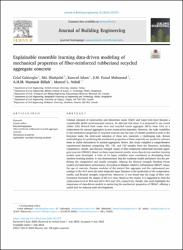| dc.contributor.author | Çakıroğlu, Celal | |
| dc.contributor.author | Shahjalal, Md. | |
| dc.contributor.author | Islam, Kamrul | |
| dc.contributor.author | Mahmood, S.M. Faisal | |
| dc.contributor.author | Billah, A.H.M. Muntasir | |
| dc.date.accessioned | 2024-04-04T18:41:54Z | |
| dc.date.available | 2024-04-04T18:41:54Z | |
| dc.date.issued | 2023 | en_US |
| dc.identifier.citation | Çakıroğlu, C., Shahjalal, Md., Islam, K., Mahmood, S.M. F., Billah, A.H.M. M. (2023). Explainable ensemble learning data-driven modeling of mechanical properties of fiber-reinforced rubberized recycled aggregate concrete. Journal of Building Engineering, 76. | en_US |
| dc.identifier.uri | https://hdl.handle.net/20.500.12846/1029 | |
| dc.description.abstract | Colossal amounts of construction and demolition waste (C&D) and waste tires have become a
considerable global environmental concern. To alleviate this issue, it is proposed to use crumb
rubber (CR) derived from waste tires and recycled coarse aggregate (RCA) from C&D as a
replacement for natural aggregates in new construction materials. However, the wide variability
in the mechanical properties of recycled concrete and the lack of reliable predictive tools in the
literature make the wide-scale adoption of these new materials a challenging task. Robust
methodologies for predicting the mechanical properties of these materials are needed to advance
them as viable alternatives to natural aggregates. Hence, this study compiled a comprehensive
experimental database comprising 451, 151, and 102 samples from the literature, including
compressive, tensile, and flexural strength values of fiber-reinforced rubberized recycled aggregate concrete (FRRAC). Based on these experimental results, seven data-driven machine learning
models were developed. A total of 16 input variables were considered in developing these
machine-learning models. It was demonstrated that the CatBoost model performed best for predicting the compressive and tensile strengths, whereas for flexural strength, Random Forest
models provided better performance. According to SHapley Additive exPlanations (SHAP) values,
the age of concrete, fineness modulus of the natural fine aggregate and the replacement percentage of the RCA were the most impactful input features in the prediction of the compressive,
tensile, and flexural strength, respectively. Moreover, it was found that the usage of fiber reinforcement increased the impact of the w/c ratio. Based on the results, it is suggested to limit the
replacement level of RCA and CR to 30% and 15%, respectively. Finally, this study highlights the
importance of data-driven models in optimizing the mechanical properties of FRRAC, offering a
useful tool for industry-scale developments. | en_US |
| dc.language.iso | eng | en_US |
| dc.publisher | Elsevier | en_US |
| dc.relation.isversionof | 10.1016/j.jobe.2023.107279 | en_US |
| dc.rights | info:eu-repo/semantics/openAccess | en_US |
| dc.subject | Crumb rubber | en_US |
| dc.subject | Recycled aggregate | en_US |
| dc.subject | Fiber-reinforced rubberized recycled aggregate concrete | en_US |
| dc.subject | Mechanical properties | en_US |
| dc.subject | Explainable ensemble learning methods | en_US |
| dc.title | Explainable ensemble learning data-driven modeling of mechanical properties of fiber-reinforced rubberized recycled aggregate concrete | en_US |
| dc.type | article | en_US |
| dc.relation.journal | Journal of Building Engineering | en_US |
| dc.identifier.volume | 76 | en_US |
| dc.relation.publicationcategory | Makale - Uluslararası Hakemli Dergi - Kurum Öğretim Elemanı | en_US |
| dc.contributor.department | TAÜ, Mühendislik Fakültesi, İnşaat Mühendisliği Bölümü | en_US |

















